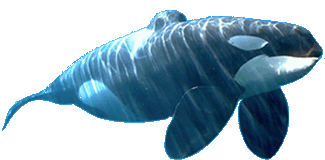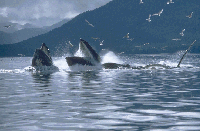
The animals that I like above all are whales. Here is some information about whales:
There are two types of whales: The Mystacoceti and the Odontoceti. The Mystacoceti
(or baleine whales) have no teeth and they feed by filtering water through baleines, big
hairy "brushes" that hang in their mouths like sieves. They open their mouths
and swallow water full of krill or fish and then they shut it and force the water out. The
water gets through the baleines but the food is trapped inside and is swallowed by the whale.
The Odontoceti(or toothed whales), on the contrary, have teeth and hunt their prey before
catching and eating it. Their prey includes giant squids, fish and, in the case of killer
whales, sea lions and even other whales.
Whales are not fish. They are mammals like us and they need air to breathe. They have to come
to the surface every now and then to breathe by the means of one(Odontoceti) or two(Mystacoceti)
holes at the top of their head. As soon as they reach the surface they breathe out with force
and that causes the fountain of foam which shoots out of their heads and has made them
detectable by the whalers. They then breathe in and dive again.
Some examples of baleine whales are the humpback whale, the grey whale, and the blue whale.
Some examples of toothed whales are the sperm whale(Moby Dick!), the killer whale(or orca) and dolphins.
Here are some more details about certain whales:
 There are three different kinds of killer whales: those
that always stay in one place, those that move around the world and those that live in the open ocean.
In all the history of killer whales these three kinds have never mixed with one another. Scientists believe that
they are on the way to evolving into three different kinds of animals. Killer whales live in
groups called pods which often consist of members of the same family. Each pod has its own vocal dialect.
The male killer whale is about 6.7 to 7.0 meters long and weighs from about 4,000 to 5,000 kilograms. The
female killer whales are about 5.5 to 6.5 meters long and weigh from about 2,500 to 3,000 kilograms.
Killer whales have 10 to 12 pairs of large conical teeth in each jaw which interlock exactly when the jaw closes.
There are three different kinds of killer whales: those
that always stay in one place, those that move around the world and those that live in the open ocean.
In all the history of killer whales these three kinds have never mixed with one another. Scientists believe that
they are on the way to evolving into three different kinds of animals. Killer whales live in
groups called pods which often consist of members of the same family. Each pod has its own vocal dialect.
The male killer whale is about 6.7 to 7.0 meters long and weighs from about 4,000 to 5,000 kilograms. The
female killer whales are about 5.5 to 6.5 meters long and weigh from about 2,500 to 3,000 kilograms.
Killer whales have 10 to 12 pairs of large conical teeth in each jaw which interlock exactly when the jaw closes.
 Orcas have a very characteristic colouration:
black back and sides and a white belly that extends up the flukes and around the throat.
They also have a big white oval patch above and behind each eye. Their body is torpedo-shaped with a
conical-shaped head and they have a tall dorsal fin at the center of their back which can reach the height
of 1.5 meters in adult females and 2 meters in adult males. The shape of the dorsal fin, the marks and cuts
on it and the grey patches that some whales have behind it are unique for each whale and therefore help
scientists identify them.
Orcas have a very characteristic colouration:
black back and sides and a white belly that extends up the flukes and around the throat.
They also have a big white oval patch above and behind each eye. Their body is torpedo-shaped with a
conical-shaped head and they have a tall dorsal fin at the center of their back which can reach the height
of 1.5 meters in adult females and 2 meters in adult males. The shape of the dorsal fin, the marks and cuts
on it and the grey patches that some whales have behind it are unique for each whale and therefore help
scientists identify them.
 They are about 12 to 15 meters long
and their flippers are almost one third of their body. They can be identified by the black
and white pattern on the bottom part of their tail, which is unique for each whale. Humpback whales can often be seen
jumping out of the water. Sometimes they also feed together, using bubbles to scare fish and gather them together.
They swim under the fish, blowing bubbles constantly. They then emerge into the middle of the circle of bubbles
with their mouth open and swallow a big amount of fish.
They are about 12 to 15 meters long
and their flippers are almost one third of their body. They can be identified by the black
and white pattern on the bottom part of their tail, which is unique for each whale. Humpback whales can often be seen
jumping out of the water. Sometimes they also feed together, using bubbles to scare fish and gather them together.
They swim under the fish, blowing bubbles constantly. They then emerge into the middle of the circle of bubbles
with their mouth open and swallow a big amount of fish.
Listen to the Humpback whale's lovely song!
Listen to the sound Humpback whales make when they are "hunting"!